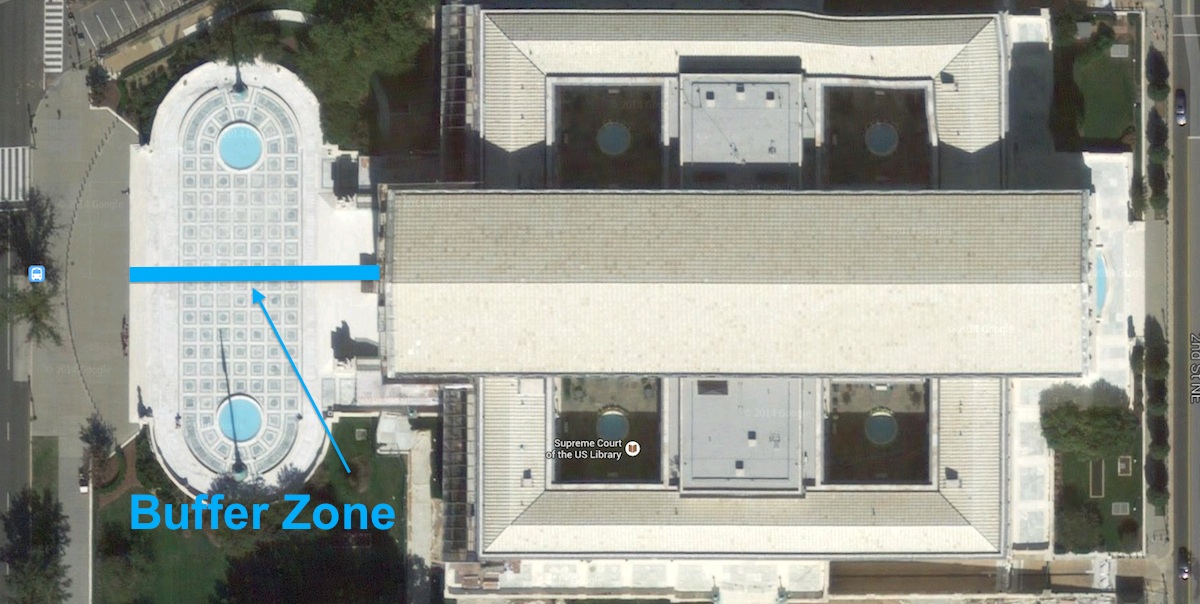The Supreme Court Technically Has Its Own 252-Foot Buffer Zone

After the Supreme Court declared that the 35-foot buffer zones separating protesters from people trying to access abortion clinics were unconstitutional, violating the First Amendment rights of those who want to spread their pro-life message, Attorney General Martha Coakley and officials from Planned Parenthood scratched their heads wondering why the court’s own invisible blockade in Washington, D.C., is exempt from the rules.
“I would note that this court decision is made by a Supreme Court that has its own buffer zone,” said Coakley during a press conference Thursday. “They are protected when they sit. Although we respect their legal decision today, I would just note that as the folks with me today, and people across [the state] know, that every day there is a battle for folks who are trying to protect and enforce their own constitutional rights for access. It’s not clear that the court’s decision fully comprehends what that looks like on a day-to-day basis.”
Coakley was referencing the fact the Supreme Court has stringent regulations in place that prohibit protesters from congregating near the front doors—or even the front steps—of the Supreme Court, keeping people expressing their First Amendment rights far away from the federal headquarters where some of the country’s most controversial decisions are made.
The Supreme Court ruling on the state’s buffer zones outside of health clinics states that, by barring protesters from the space outside of a building’s entrance, it regulates access to “public ways” that have historically served as a platform for First Amendment speech to be freely exchanged.
But if the Supreme Court wants people with differing opinions to be able to come together and talk about their respective views, why aren’t similar interactions allowed on the court’s plaza?
According to guidelines that were tweaked by the Supreme Court in June 2013, it’s unlawful for protesters to demonstrate on Supreme Court building grounds. The rules state:
The term ‘demonstration’ includes demonstrations, picketing, speechmaking, marching, holding vigils or religious services, and all other like forms of conduct that involve the communication or expression of views or grievances, engaged in by one or more persons, the conduct of which is reasonably likely to draw a crowd or onlookers.
The Wire reported in 2013 that the court’s updated regulations were in response to a lawsuit filed by a college student who was arrested by police two years prior, while standing on the plaza, for carrying an anti-racism sign that took aim at officers.
The court’s rules about protests on their grounds don’t apply to the sidewalks surrounding the building, but those areas are roughly 252 feet from the court’s doors. The buffer zone separating the plaza from the sidewalks is meant to keep the area clean and safe, and maintain “suitable order and decorum” on the property, according to the regulations.
What’s troubling about the regulations is they take an opposite approach to what the court said pro-life protesters should be allowed to do in front of abortion clinic doors in Massachusetts. But much the like Justices have the power to call the shots on rulings, federal law gives governmental buildings and entities the ultimate discretion when setting security guidelines and protocols.
Like Coakley, Martha Walz, president and CEO of the Planned Parenthood League of Massachusetts, was also perplexed by the disparity between what the court justifies as free speech zones on their grounds, versus those in Massachusetts.
“The Attorney General alluded to the fact that the Supreme Court has its own buffer zone,” said Walz. “It was silent today about the constitutionality of its own buffer zone. It side-stepped the issue of whether or not its own buffer zone is constitutional, but the rationale expressed in the decision today certainly calls into question the constitutionality of the [court’s] buffer zone, so it will be interesting to see going forward how they address the applicability of today’s decision to what they get the benefit of each and every day that the women in our healthcare centers will no longer get the benefit of.”
Coakley and members of Planned Parenthood have vowed to move forward to find other ways to protect patients going in and out of health facilities in the Commonwealth.


